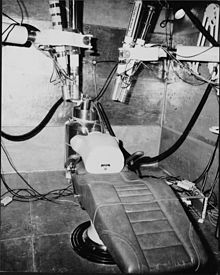低背景鋼

低背景鋼(英語:Low-background steel),或譯「低本底鋼」,亦稱先原子鋼[1](pre-atomic steel)[2]與二戰前鋼(pre-war steel)[3],是在1940年代和1950年代第一代原子彈爆炸前生產的鋼材。由於在1945年,隨着三位一體核試驗、廣島、長崎核轟炸,以及冷戰早期一系列核武器試驗的進行,世界背景輻射量有明顯升高。現代生產的鋼鐵由於普遍使用大氣氣體而被放射性同位素污染,低背景鋼的稱呼由此而來。因為其沒有受到過此類污染,這種鋼材被使用在高精度放射性同位素檢測裝置上。
放射性同位素污染[編輯]
從1856年到二十世紀中葉,煉鋼採用的是貝塞麥轉爐煉鋼法,這種方法通過向高爐中鼓入空氣來將生鐵轉換為鋼。到20世紀中葉,許多煉鋼廠已經改為使用氧氣吹頂制鋼流程,這種方法使用純氧代替了空氣。但是此兩種方法都使用了容易被空氣中微粒子污染的大氣氣體。當今的大氣中攜帶有各種放射性同位素,比如鈷-60,就會沉積在鋼鐵中,使其表現出微弱的放射性。[4]
世界上的人為背景輻射於1963年達到了高峰,高於自然水準0.15毫西弗。由於這一年通過了部分禁止核試驗條約,人為背景輻射程自此開始呈幾何級數下降,到每年高於自然水準0.005毫西弗。[5]
製造[編輯]
現今低本底鋼的主要來源是在三位一體核試驗之前所沉入水中的各種船舶,其中最有名的是在一戰時期於蘇格蘭斯卡帕灣鑿沉的德國戰列艦。 [6]
由於鈷60存在於廢、舊鋼鐵回收供應鏈,因此近代生產的鋼鐵仍會受到鈷60之污染。[7]不過2000年代以後人為活動產生的背景輻射接近自然界的水準,在控制鋼材煉製原料來源(主要方法是不使用回收鋼材)、改進煉製工藝的情況下,仍可製造出符合要求的低本底鋼。[8]
應用[編輯]
低本底鋼主要應用在以下裝置上:
由於這些是用於測試放射性排放量的裝置,需要在非常低放射性的環境下才能正常工作。低背景計數艙室是用低本底鋼製成,具有非常強的輻射遮蔽能力,用於測量細微核排放。[9]
參考資料[編輯]
- ^ (美)馬哈菲. 开凿运河,治疗癌症,飞往木星. 原子的觉醒 解读核能的历史和未来. 科學新文獻. 上海: 上海科學技術文獻出版社. 2011-04: 180. ISBN 978-7-5439-4828-0 –透過讀秀.
- ^ James Mahaffey. Atomic Awakening: A New Look at the History and Future of Nuclear Power. : 226–227 (英語).
- ^ M. Manohari; R. Mathiyarasu; V. Rajagopal; V. Meenakshisundaram; R. Indira. Calibration of phoswich-based lung counting system using realistic chest phantom. Radiation Protection Dosimetry. 2011, 144 (1-4): 427–432.
- ^ Adams, Cecil. Is steel from scuttled German warships valuable because it isn't contaminated with radioactivity?. The Straight Dope. December 10, 2010 [2015-07-31]. (原始內容存檔於2015-09-16).
- ^ United Nations Scientific Committee on the Effects of Atomic Radiation (UNSCEAR), Sources and Effects of Ionizing Radiation (UNSCEAR 2008 Report): Volume I, New York: United Nations: 6, 2010 [2015-07-31], ISBN 978-92-1-142274-0, (原始內容存檔於2019-07-16),
The estimated annual per caput effective dose of ionizing radiation due to global fallout from atmospheric nuclear weapons testing was highest in 1963, at 0.11 mSv, and subsequently fell to its present level of about 0.005 mSv (see figure II). This source of exposure will decline only very slowly in the future as most of it is now due to the long-lived radio-nuclide carbon-14.
- ^ Butler, Daniel Allen. Distant Victory: the Battle of Jutland and the Allied Triumph in the First World War. Westport, Connecticut, USA: Praeger Security International (Greenwood Publishing Group). 2006: 229 [2015-07-31]. ISBN 0-275-99073-7. (原始內容存檔於2014-11-04).
- ^ Reducing Risks in the Scrap Metal Industry - Sealed Radioactive Sources (PDF) (IAEA/PI/A.83 / 05-09511), Austria: International Atomic Energy Agency (IAEA): 2–6, September 2005 [2015年7月31日], (原始內容 (PDF)存檔於2006年6月14日)
- ^ 低放射化フェライト鋼製造技術の現状と課題 (PDF), Japan: プラズマ・核聚變學會, January 2011 [2018-12-13], (原始內容存檔 (PDF)於2016-08-03)
- ^ Aaron, D. Jayne; Berryman, Judith. Rocky Flats Plant, Emergency Medical Services Facility - HAER No. CO-83-S (Rocky Flats Plant, Building 122). U.S. Department of Energy, Office of Legacy Management. 1997 [2015-07-31]. (原始內容存檔於2016-04-10).
